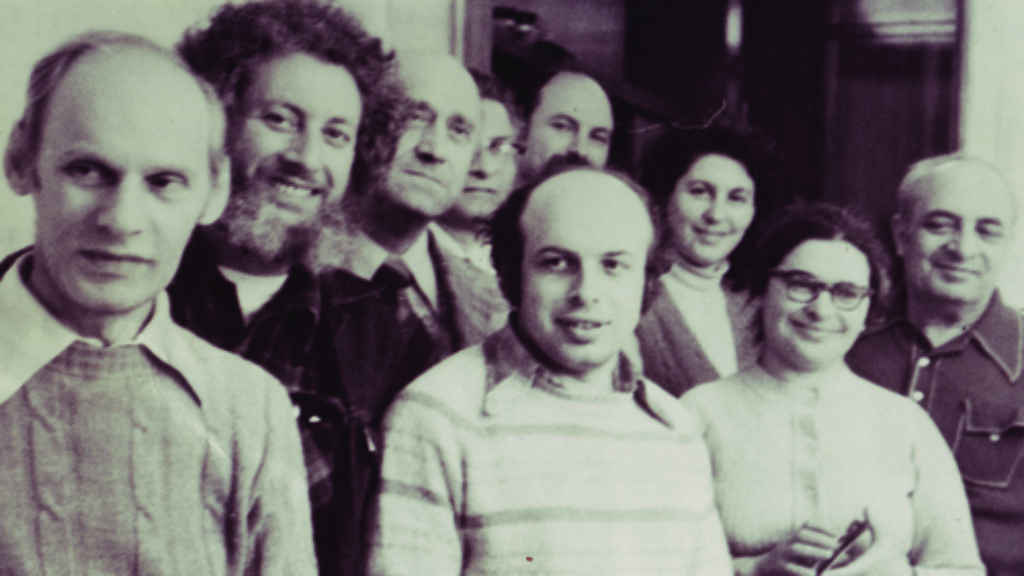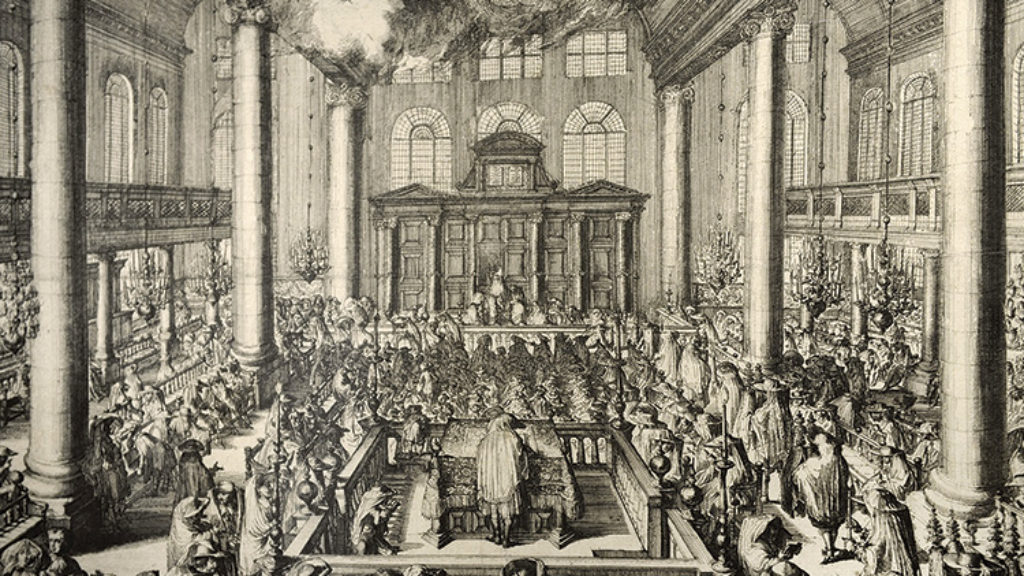Are We all Kahanists Now?
Historians of American Jewry and Israel alike have for decades been reluctant to dwell on the story of Meir Kahane. On the whole, as Shaul Magid shows, they would rather push him under the rug than write about him. There is still not a good scholarly biography of the man, one that would go behind the headlines and, through Freedom of Information Act requests, interviews, and archival research, deeply explore the most crucial chapters of his altogether unique life.
The story that has not yet been thoroughly told is that of a first-generation American born in Brooklyn in 1932 into a Revisionist Zionist home who got into trouble during his teenage years for throwing rotten eggs at British foreign secretary Ernest Bevin in a protest against restrictions on Jewish immigration to Palestine (when he wasn’t turning in an unremarkable performance as a student at the Brooklyn Talmudical Academy). Scuffles with neighborhood toughs, around the same time, left him more scarred by antisemitism than imbued with Orthodox Judaism, from which he departed for a time before earning ordination from the Mir Yeshiva.
After receiving a law degree from New York Law School and an MA in international relations from NYU, Kahane worked as both a part-time rabbi and an FBI informant, infiltrating the John Birch Society and also leftist groups under the pseudonym Michael King. During this time, he lived a double life as a family man with small children at home in Queens and as a man about town on the Upper East Side, with a lover named Gloria Jean D’Argenio who jumped off the Queensboro Bridge allegedly because Kahane ended their affair.

Kahane’s public career began with freelance writing for the Jewish Press, but, as Magid points out, it only really took off with his founding in 1968 of the Jewish Defense League (JDL), an organization devoted to fighting antisemitism in the most literal sense, often brawling with African Americans in Brooklyn. It soon focused its attention, however, on the harassment of Soviet officials in the United States and Kahane’s important (if often overlooked) role in the struggle for Soviet Jewry. These activities led to Kahane in 1971 being given a five-year suspended sentence for bomb making, which provoked his immigration to Israel.
Two years later, he ran for the Knesset. He didn’t win a seat, but with almost thirteen thousand votes, he did succeed in building the base of a political movement among Mizrahi Jews in the Negev, Soviet and American immigrants who admired the JDL, and other hawks. The logo of their party, called Kach! (Thus!), was a clenched yellow fist against a black Jewish star. Eventually, Kahane’s demagoguery and anti-Arab bigotry did win him a seat in the Knesset, which he occupied from 1984 to 1988, until Kach was banned from that body in accordance with antiracism legislation, which was aimed especially at him. He then retreated to Yeshivat Ha-Raayon Ha-Yehudi (the Seminary of the Jewish Idea), which he founded in Jerusalem. He was assassinated by an Egyptian Islamist after giving a speech in Brooklyn on November 6, 1990.
Magid, a Dartmouth professor of Jewish thought and man of the left who has written widely on Hasidism, Kabbalah, and contemporary Jewish life and politics, doesn’t make it his aim to deepen our knowledge of Meir Kahane’s life. His book is a thematic intellectual biography, focused on mapping “the trajectory of his thought in the context of the changing contours of postwar America and later in Israel during the development of right-wing Zionism in the 1970s and 1980s.”
Magid frames his study with an anecdote. A few years ago, he was at a bar mitzvah in a Modern Orthodox synagogue and told the guy next to him in the kiddush line that he was working on a book about Kahane. His new friend, who was a “professional-looking man, probably in his mid-fifties” and seemed “educated, friendly, and not particularly ideological,” told Magid, “If you want my opinion, I agree with everything Kahane said. Everything he predicted came true. He just should have said it in a nicer way.” This is a more genteel, American version of the “Kahane Tzadak” (Kahane Was Right) graffiti, which is still scrawled on Israeli walls.
Magid doesn’t agree, of course, but his study of Kahane is designed to show us how much twenty-first-century Jews have inherited from a man whom most have tried to forget. Although Kahane’s militancy has been rejected, Magid notes, “many of his basic precepts have been embraced among present-day American Jewry.” Kahane, Magid maintains, “is best viewed as a cultural icon who was able to shift the discourse of American Jewry, and later Israeli politics, through sheer will, perseverance, and maniacal certitude.” In its effort to show how Kahane did this, Magid’s book is, he writes, “an intervention into contemporary Judaism and Jewishness as much as it is a book about Meir Kahane.”
Kahane was, Magid observes, diametrically opposed to the “Jewish liberalism” of his day. He lambasted the liberal establishment for selling out Jewish substance and survival for life in suburbia, leaving the Jewish residents of ethnic neighborhoods behind to fight what he perceived as the real battles of a resurgent new antisemitism only two decades after the Holocaust. Whether antisemitism was a feature or a bug of the new Black radicalism, Kahane was convinced that it was the Jews who were getting squeezed, as Magid puts it, as a “middleman in the coming race wars.” But Jews could learn a thing or two from their opponents: “if the Black Panthers and Black Nationalists wanted to construct a new Black Man (or woman) through ‘Black is Beautiful,’” Kahane wanted to create a “New Jew” in opposition to what he called the “Uncle Irvings.”
Within the Jewish community, Kahane maintained, liberalism and individualism were undermining Jewish tradition and destroying the Jews’ spiritual identity. The bar mitzvah, he quipped, was “all bar and no mitzvah.” If antisemitism failed to undo the Jews of America, intermarriage would. Indeed, according to Magid, “Kahane warned of the dangers of intermarriage (e.g., writing a book on the subject in 1974) long before the ‘intermarriage crisis’ became standard fare in American Jewish circles.”
Kahane, according to Magid, “decried the anti-Semitism on the left when most establishment figures were worried about anti-Semitism on the right. And he argued for a Jewish turn toward conservatism a full decade before the rise of neoconservatism.” Kahane did, indeed, rather compulsively, see antisemitism everywhere, even where others had missed it, but Norman Podhoretz has no reason to regard him as a predecessor. And even if he had been one, can it really be argued that it was Kahane who did “shift the discourse” in the way that Magid suggests? Magid also reports that Kahane “was an ‘Israel right or wrong’ advocate before AIPAC and before Israel became the civil religion of American Jewry.” Magid acknowledges that the New York intellectuals who eventually became the neoconservatives always disdained Kahane and never published him. And yet, if anyone is responsible for shifting the discourse of American Jewry to the right, it is the neoconservatives, and if Kahane didn’t influence them, how did his ideas shift the discourse?
Kahane’s zealous Zionism, Magid tells us, was on display before his “radical ideas seeped into the political and cultural mainstream,” in organizations like AIPAC. But AIPAC was established on the American scene well before Kahane was and does not reflect his influence. Magid is, evidently, less interested in discerning how changes in the intellectual climate actually take place than he is in tarring mainstream American Jewry with a JDL brush.
Magid is also mistaken about Kahane’s impact when he identifies him as one of the first to raise the alarm about intermarriage, “writing a book on the subject in 1974,” which, he writes, was “longbefore the ‘intermarriage crisis’ became standard fare in American Jewish circles.” Had Magid reread his own footnotes before writing the introduction, he would have seen that Kahane’s Why Be Jewish? Intermarriage, Assimilation, and Alienation appeared in 1977, not 1974. But even if Kahane had published the book three years earlier, it would have been but one of many diagnoses of intermarriage that came out in the 60s and early 70s. It was the famous 1964 Look magazinearticle, “The Vanishing American Jew,” that really kicked things off. But there were other landmarks in the communal discussion, such as Marshall Sklare’s March 1970 Commentary article titled “Intermarriage and Jewish Survival,” in which one of the country’s leading Jewish sociologists argued that “the ever-increasing incidence of intermarriage . . . strikes at the very core of Jewish group existence.” Magid mentions none of this and likewise overlooks such things as the full-page advertisement placed in the New York Times by the Board of Jewish Education of Greater New York in 1974 proclaiming that “If You’re Jewish, Chances Are Your Grandchildren Won’t Be.”
Magid clearly understands how much Kahane, who was certainly a man of the right, was himself influenced by the left of his own day. He shows how he borrowed from Black militants, the violent leftist underground, and even the left-leaning New Jews and Radical Zionists:
Kahane was no less American in his activism than Abbie Hoffman, and the JDL no less American than the Yippies or SDS. All were protest movements out to undo the establishment by testing the elasticity of the American liberal system, even as both transgressed the norms of that system in order to make their voices known.
This is no less true of Kahane’s activism in Israel, as other scholars, who are not always acknowledged in Magid’s footnotes, have already pointed out (my own book City on a Hilltop: American Jews and the Israeli Settler Movement made this argument).
In Israel, Magid tells us, “The trajectory of Kahane’s career moved from being a social critic of, and activist against, liberalism and what it produced in America, to a religious ideologue and apocalyptic thinker.” Magid does a thorough job of elucidating Kahane’s peculiarly ultranationalist, xenophobic, and violent ideology and delineating its dangers, though he also exaggerates the extent of his influence within the national-religious camp in his lifetime. In the 1970s and 1980s, Kahane was widely rejected and reviled by native Israeli Gush Emunim elites, who felt that his style of activism undermined their attempts to legitimize the settler movement. But today he does indeed have extremist disciples, including his grandson Meir Ettinger, who leads a group of radical settlers who reject secular authority and have had a more substantial impact on the Israeli far right.
Shaul Magid has succeeded in explicating the ideas of a late and mostly unlamented Jewish leader, a man who operated far from the mainstream, both in the land of his birth, the United States, and in Israel, the land to which he migrated. But his effort to suggest that Kahane significantly shifted the discourse in both countries, that we should recognize that, as it were, we are all Kahanists now, is much less than convincing. Magid has reminded us how odious Kahane’s views were, but he has given us little reason to believe that we have unwittingly come to share them.
Comments
You must log in to comment Log In
Suggested Reading

Let My People Go
Many of the heroes of the Soviet Jewry movement have been unsung, until now.

Lessons of the Soviet Jewish Exodus
Between the mid-1960s and 1991, more than two million Jews left the USSR. To the extent that the Soviet Jewish exodus is remembered, its lessons are misunderstood.
War & Peace & Judaism
Robert Eisen was walking to campus on 9/11 when he saw a dark cloud above the Pentagon. Alick Isaacs fought for the IDF in Lebanon. Their experiences prompted them to rethink peace and Judaism.

Who Tried to Kill Spinoza?
According to early biographers, somebody tried to kill Spinoza on the streets of Amsterdam. Is the story true, and, if so, who were his attackers?
Phil Cohen
If the reviewer got it right, the book under review represents the kind of thinking one encounters frequently, viz., the identification of a narrow phenomenon with a significantly larger whole. The results of careful research can be ruined when put to sloppy use